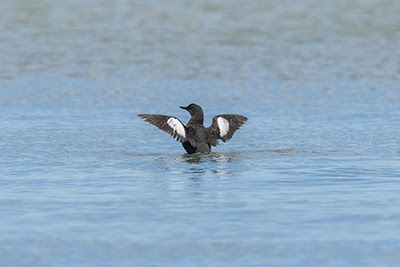The first two wader canon netting sessions of the ‘autumn’ are a highlight of the SCAN season. Primarily because they target Curlew & Ringed Plover both of which are beautiful, if not contrasting, species close up. Secondly because the weather in August is generally better than later autumn & winter catches. Even so I wasn’t expecting be wearing shorts & tee-shirt on what was forecast to be one of the hottest days of the current mini heatwave we’re experiencing in the UK.
Steve informed everyone attending that it was likely to be a dry catch so I opted for wellies and a pair of waterproof over trousers just in case we caught at a slightly later time than planned where we might get a bit wet. Far better than neoprene waders in this heat!
Unfortunately things didn’t go quite to plan and after meeting up with the rest of the team & parking up I went to change my footwear only to find I’d inadvertently thrown one of my wife’s diminutive size 5’s in with my size 9’s. Worse than that they were both for the right foot! Trainers and wet feet it was then!
Crossing a small ford as we carried the gear to the designated net set point my trainers soon filled with a mixture of sand, black estuarine mud and salt water. Not unpleasant but after a while the heat being generated made if feel like my feet were being gently poached.
Setting the nets and digging the canons into a pebbly beach is sweaty work. The outline of the furled nets has to be broken up with tideline debris to make it look more natural. In this case sand infested rotting seaweed.
Nets set we settled down out of site in the dunes, waiting for the tide to push the birds into the catching area, for the next couple of hours during which it got hotter and hotter and my feet slowly began to resemble boiled hams. The water proof trousers came in handy as I unzipped them to spread across my rapidly reddening legs.
We could hear birds moving and radio messages from Steve & Lizzie, watching from a hide with the firing box, kept us informed of what was going on. Dozing in the sunshine I wasn’t expecting the sudden ‘boom’ as the canons fired. We normally get a 3,2,1 countdown but the approach of a plane that had previously caused the birds to lift resulted in a split second decision to take the catch.
Once the canons fired it’s a sudden change from inactivity to sprinting to the net to make sure the birds are covered and kept safe & secure before extracting them and placing them gently in specially designed Curlew holding cages where they can stand up to avoid cramp. Curlews are easily stressed so all this takes place with the minimum amount of noise and ensuring the birds welfare.
A good catch of 67 Curlew was made along with a single Oystercatcher. A number of retraps from previous years provided valuable data on adult survival rates. Birds were quickly ringed and then processed - aged, moult score recorded, wing length measured, bill length measured and finally weighed before releasing.
 |
 |
| Recording moult score. Three outermost primaries are old. One about 2/3 grown and inner ones new. |
Moult is recorded from the inside out meaning the moult score of the inner primaries are recorded first.
Biometrics help identify male and female Curlew with the females being larger with longer bills. They can also help us identify Scandinavian birds as they are bigger again - especially the females.
Processing complete we packed the gear up and hand balled it to a point where it could be loaded into Steve’s truck. A sweaty squelch across the marsh. By this time my sodden, sweaty socks had been joined by equally sweaty shorts & teeshirt mingled with the aroma of rotting seaweed and Curlew poop.
Arriving home, desperate for a cold drink and a shower, I was greeted by our two youngest granddaughters who’d come to play in our garden along with Indy the Labrador. The dog, having a more acute sense of smell, came towards me wagging her tail before wrinkling her nose and abruptly veering off to sniff something slightly more pleasant. The two girls came towards give me a hug, as I knelt down to greet, them before the youngest said, ‘Pooh, grandad you stink’ and ran off to say goodbye to their sweeter smelling nanny. Four year olds are nothing if not brutally honest. A great day and good to see some familiar faces and some new ones.
Just to cap off a good day I was absently mindedly collecting the bins from the front verge when I heard a familiar call overhead. It took a few seconds to register as, along with my iphone, my brain wasn't quite functioning as it should due to overheating - a migrating Curlew flying over heading towards the Dee Estuary. A good local record.














































































